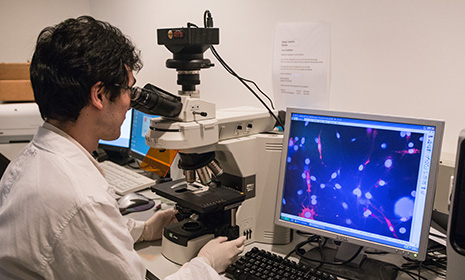林讚育

公共衞生實驗室科學
- BSc, PhD
个人简介
Professor Tommy Lam received his BSc (Bioinformatics) and PhD (Molecular Virology) in The University of Hong Kong, and had postdoctoral training in Pennsylvania State University and University of Oxford. His main research interest is the evolution, epidemiology and ecology of infectious diseases. He uses integrative genomic approach to determine the patterns, drivers and mechanisms of the emergence of pathogens at human-animal interface including influenza viruses and coronaviruses, as well as some bacterial pathogens and their antibiotic resistance emergence. His research has contributed to important understanding of the origins, evolution and transmission of newly emerging pathogens such as H7N9 influenza (Nature 2013, Nature 2015), MERS coronavirus (EID2013, Science 2016) and COVID-19 coronavirus (Nature 2020). He is also leading research studies on mosquitoes and their arboviruses in Hong Kong, China. Professor Lam is interested in bioinformatics methods. He is leading the development of several computational tools and databases for the genomic analysis.
Professor Lam received Novartis Vaccines Award for Epidemiology of Infectious Diseases from International Society for Infectious Diseases in 2008, and the Newton Research Fellowship from Royal Society UK in 2010. He received National Science and Technology Progress Award (Special Award, 2017) from State Council of the People’s Republic of China. He has been ranked top 1% scholars at HKU based on Essential Science Indicators between 2016-2020. He was awarded with The National Natural Science Foundation of China (NSFC) Excellent Young Scientists Fund (Hong Kong and Macau) in 2019.
In addition to the teaching undergraduate and postgraduate courses in the University, Professor Lam also taught in several international workshops and online courses. He organised the Croucher Summer Course: Computational Genomics of Viral Evolution and Epidemiology to promote high-quality technical training and research collaboration among the local and international scientists in this field.
发表的部分文章
- Leung K, Shum MH, Leung GM, Lam TT#, Wu JT. 2021. “Early transmissibility assessment of the N501Y mutant strains of SARS-CoV-2 in the United Kingdom, October to November 2020.”. Euro Surveill (2021) 26. (IF: 6.454)
- Lam TT*, Jia N*, Zhang YW*, Shum MH*, Jiang JF, Zhu HC, Tong YG, Shi YX, Ni XB, Liao YS, Li WJ, Jiang BG, Wei W, Yuan TT, Zheng K, Cui XM, Li J, Pei GQ, Qiang X, Cheung WY, Li LF, Sun FF, Qin S, Huang JC, Leung GM, Holmes EC, Hu YL, Guan Y, Cao WC. “Identifying SARS-CoV-2 related coronaviruses in Malayan pangolins”. Nature (2020) DOI: 10.1038/s41586-020-2169-0. (IF: 43.070)
- Boni MF, Lemey P, Jiang X, Lam TT, Perry B, Castoe T, Rambaut A and Robertson DL. “Evolutionary origins of the SARS-CoV-2 sarbecovirus lineage responsible for the COVID-19 pandemic” Nature Microbiology (2020) DOI: 10.1038/s41564-020-0771-4 (IF: 17.745)
- Lam TT, Tang JW, Lai FY, Zaraket H, et al on behalf of INSPIRE (International Network for the Sequencing of Respiratory Viruses). “Comparative global epidemiology of influenza, respiratory syncytial and parainfluenza viruses, 2010-2015” Journal of Infection (2019) 79 (4), 373-382. (IF: 5.099)
- Rodríguez-Nevado C, Lam TT, Holmes EC, Pagán I. "The impact of host genetic diversity on virus evolution and emergence." Ecology Letters (2018) 21:253-263. (IF: 8.699)
- Yu G, Smith D, Zhu H, Guan Y, Lam TT#. “ggtree: an R package for visualization and annotation of phylogenetic trees with their covariates and other associated data” Methods in Ecology and Evolution (2017)8(1): 28-36. #correspondence (IF: 7.099)
- Lam TT, Zhu H, Guan Y, Holmes EC. ”Genomic Analysis of the Emergence, Evolution and Spread of Human Respiratory RNA Viruses” Annual Review of Genomics and Human Genetics (2016) 17. (IF: 7.914)
- Sabir JSM*, Lam TT*, Ahmed MMM*, Li L*, Shen Y, Abo-Aba SEM, Qureshi MI, Abu-Zaid M, Zhang Y, Khiyami MA, Alharbi NS, Hajrah NH, Sabir MJ, Mutwakil MHZ, Kabli SA, Alsulaimany FAS, Obaid AY, Zhou B, Smith DK, Holmes EC, Zhu H, Guan Y. ”Co-circulation of three camel coronavirus species and recombination of MERS-CoVs in Saudi Arabia” Science (2016) 351:81-4. (IF: 41.063)
- Lam TT*, Zhou B*, Wang J*, Chai Y*, Shen Y*, Chen X*, Ma C, Hong W, Chen Y, Zhang Y, Duan L, Chen P, Jiang J, Zhang Y, Li L, Poon L, Webby R, Smith D, Leung G, Peiris M, Holmes E, Guan Y, Zhu H. "Dissemination, divergence and establishment of H7N9 influenza viruses in China" Nature, (2015) 522: 102-105. (IF: 43.070)
- Lam TT*, Wang J*, Shen Y*, Zhou B, Duan L, Cheung CL, Ma C, Lycett SJ, Leung CY, Chen X, Li L, Hong W, Chai Y, Zhou L, Liang H, Ou Z, Liu Y, Farooqui A, Kelvin DJ, Poon LL, Smith DK, Pybus OG, Leung GM, Shu Y, Webster RG, Webby RJ, Peiris JS, Rambaut A, Zhu H, Guan Y. "The genesis and source of the H7N9 influenza viruses causing human infections in China" Nature,(2013) 502: 241-244. (IF: 43.070)
- Ng SC, Lam EF, Lam TT, Chan Y, Law W, Tse PC, Kamm MA, Sung JJ, Chang FK, Wu JC. "Effect of Probiotic Bacteria on the Intestinal Microbiota in Irritable Bowel Syndrome" Journal of Gastroenterology and Hepatology, (2013) 28(10):1624-31.
- Lam TT, Ip HS, Ghedin E, Wentworth DE, Halpin RA, Stockwell TB, Spiro DJ, Dusek RJ, Bortner JB, Hoskins J, Bales BD,Yparraguirre DR, Holmes EC. “Migratory flyway and geographical distance are barriers to the gene flow of influenza virus among North American birds” Ecology Letters, (2012). 15(1):24-33. (IF: 8.699)
- Lam TT, Hon CC, Pybus OG, Sergei KP, Wong TY, Yip CW, Zeng F, Leung FC.“ Evolutionary and transmission dynamics of reassortant H5N1 influenza virus in Indonesia.” PLoS Pathogens, (2008). 22;4(8):e1000130 (IF: 6.463)








.png)
